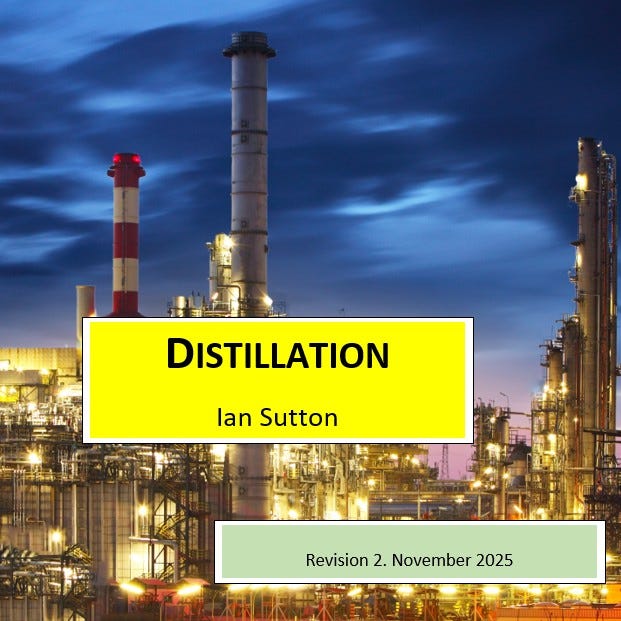Primer: Distillation
2nd Edition
Purchasing Information
Kindle
Price: $25 (U.S.)
The Primer Series
Information to do with other products in this series is available here.
Overview
Distillation remains the backbone of chemical and energy processing, separating complex mixtures into valuable products.
Distillation: A Primer explains the principles, design, and operation of both batch and continuous systems — from moonshine stills to refinery towers. The Primer covers column internals, reboilers, reflux control, and advanced methods such as azeotropic and extractive distillation. The Primer also addresses economics, safety, and environmental management, referencing key industry standards.
Written for engineers, operators, and technical professionals, it combines practical insight with clear explanation.
The Primer concludes with a 10-question quiz, making this an ideal resource for training and professional development in process operations.
Table of Contents
Introduction
Principles of Distillation
Batch Distillation
Specialty and Fine Chemicals
Pharmaceutical Manufacturing
Solvent Recovery
Research Applications
Continuous Distillation
Feed Composition
Reflux and Reflux Ratio
Close-Boiling Separations
Azeotropic Distillation
Extractive Distillation
Reboilers
Thermosyphon Reboiler
Kettle Reboiler
Forced Circulation Reboiler
Column Internals
Trays (Plates)
Packing
Operations
Startup
Steady-State Operation
Shutdown
Operational Challenges
Economics of Distillation
Safety and Environmental
Standards and Best Practices
Conclusion
Knowledge Check: 10-Question Quiz
The Quiz
Choose the best answer for each of the following questions.
1. What is the primary separation principle behind distillation?
A) Difference in density
B) Difference in molecular weight
C) Difference in volatility
D) Difference in solubility
2. In a distillation column, what is the purpose of the reboiler?
A) To cool down the overhead vapor
B) To vaporize the bottom liquid and drive separation
C) To neutralize acid gases
D) To remove dissolved solids
3. What does a reflux ratio of 3.0 mean?
A) 3% of the vapor is returned as reflux
B) Three components are being separated
C) The top temperature is three times the bottom temperature
D) Three units of reflux are returned for every one unit of distillate withdrawn
4. Which type of reboiler uses a pump to circulate liquid through the heat exchanger?
A) Thermosyphon reboiler
B) Forced circulation reboiler
C) Kettle reboiler
D) Bubble-cap reboiler
5. Which of the following is a disadvantage of using trays in a distillation column?
A) Low pressure drop
B) Higher pressure drop than packing
C) Inability to handle large flow rates
D) High risk of vapor leaks
6. What operational problem occurs when vapor flow is too low to hold liquid on trays?
A) Flooding
B) Entrainment
C) Weeping or dumping
D) Foaming
7. Why is batch distillation preferred in pharmaceutical manufacturing?
A) It provides higher throughput
B) It eliminates the need for cleaning
C) It operates continuously without interruption
D) It allows for traceability, cleaning, and flexible product control
8. What is the primary reason for using packing instead of trays in vacuum distillation?
A) Lower pressure drop
B) Higher heat input
C) Increased equipment weight
D) Easier to clean
9. During startup, why is the feed introduced slowly?
A) To reduce operator workload
B) To establish stable liquid and vapor flows
C) To minimize catalyst loss
D) To avoid reflux buildup
10. Which of the following standards governs the mechanical integrity of pressure vessels used in distillation?
A) NFPA 30
B) OSHA 1910.147
C) ASME Section VIII
D) ISA-TR106.00.02




I'm giving this a read.